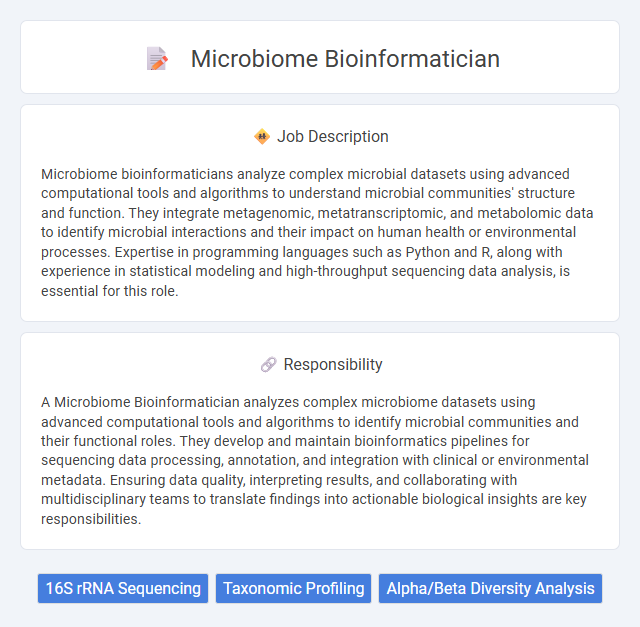
Microbiome bioinformaticians analyze complex microbial datasets using advanced computational tools and algorithms to understand microbial communities' structure and function. They integrate metagenomic, metatranscriptomic, and metabolomic data to identify microbial interactions and their impact on human health or environmental processes. Expertise in programming languages such as Python and R, along with experience in statistical modeling and high-throughput sequencing data analysis, is essential for this role.
Individuals with strong analytical skills and a background in biology or computer science are likely to be well-suited for a microbiome bioinformatician role, as it involves interpreting complex datasets and understanding microbial communities. Those comfortable working with large-scale genomic data and possessing proficiency in programming languages such as Python or R may have a higher probability of success. Candidates who enjoy interdisciplinary research and have attention to detail could find this job rewarding and fitting to their skill set.
Qualification
Microbiome bioinformaticians typically require a strong background in computational biology, with proficiency in programming languages such as Python, R, and SQL for data analysis. A graduate degree in bioinformatics, microbiology, computational biology, or a related field, combined with experience in metagenomic sequencing and microbiome data interpretation, is essential. Expertise in statistical analysis, microbial ecology, and familiarity with databases like SILVA or Greengenes enhances the ability to derive meaningful insights from complex microbial community datasets.
Responsibility
A Microbiome Bioinformatician analyzes complex microbiome datasets using advanced computational tools and algorithms to identify microbial communities and their functional roles. They develop and maintain bioinformatics pipelines for sequencing data processing, annotation, and integration with clinical or environmental metadata. Ensuring data quality, interpreting results, and collaborating with multidisciplinary teams to translate findings into actionable biological insights are key responsibilities.
Benefit
Microbiome bioinformatician roles likely offer significant benefits, including opportunities to work with cutting-edge data analysis tools and contribute to advancing human health and environmental research. The position may provide a collaborative environment that fosters interdisciplinary learning and innovation. Competitive salaries and potential for career growth in the expanding field of microbiome research are also probable advantages.
Challenge
Microbiome bioinformaticians likely face challenges in analyzing vast and complex genomic data to accurately characterize microbial communities. The probability of encountering difficulties increases when integrating multi-omics data and managing issues related to data variability and sequencing errors. Developing robust computational tools that can efficiently handle high-dimensional datasets is expected to remain a key obstacle in this field.
Career Advancement
Microbiome bioinformaticians leverage advanced computational tools to analyze complex microbial data, driving innovations in health, agriculture, and environmental sciences. Career advancement often involves developing expertise in multi-omics data integration, machine learning applications, and leadership in interdisciplinary research projects. Securing roles such as senior bioinformatics scientist, principal investigator, or data science manager enhances professional growth and impact in the microbiome research field.
Key Terms
16S rRNA Sequencing
A Microbiome bioinformatician specializing in 16S rRNA sequencing analyzes microbial communities by processing sequencing data to identify and classify bacteria based on conserved genetic markers. Expertise in computational tools such as QIIME, Mothur, and DADA2 enables accurate taxonomic assignment and diversity analysis critical for studying microbiome composition and dynamics. Proficiency in statistical analysis and data visualization supports interpretation of complex datasets, facilitating insights into microbial roles in health, disease, and environmental interactions.
Taxonomic Profiling
Microbiome bioinformaticians specializing in taxonomic profiling analyze complex microbial communities by processing high-throughput sequencing data to identify and classify microorganisms at various taxonomic levels. They utilize advanced algorithms, such as marker gene analysis and metagenomic classifiers like QIIME, MetaPhlAn, or Kraken, to generate accurate profiles of community composition and diversity. Expertise in statistical analysis, data visualization, and the interpretation of microbiome datasets supports the development of insights into microbial ecology, health associations, and environmental impacts.
Alpha/Beta Diversity Analysis
Microbiome bioinformaticians specialize in analyzing microbial communities using Alpha and Beta Diversity metrics to assess species richness and compositional differences across samples. Proficiency in software tools such as QIIME2, mothur, and R packages (e.g., vegan, phyloseq) is essential for processing high-throughput sequencing data and interpreting ecological variance. Expertise in statistical methods like PERMANOVA and ordination techniques (e.g., PCoA, NMDS) enables rigorous evaluation of microbiome diversity and its correlation with environmental or clinical variables.
 kuljobs.com
kuljobs.com